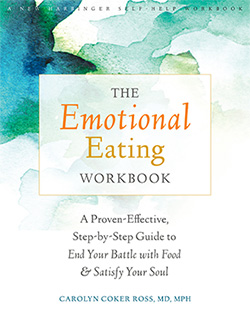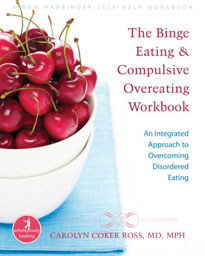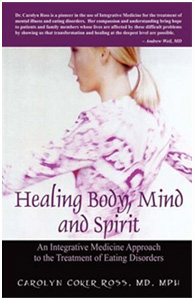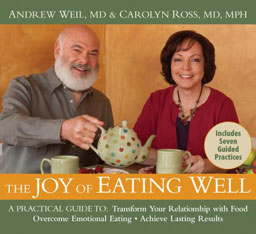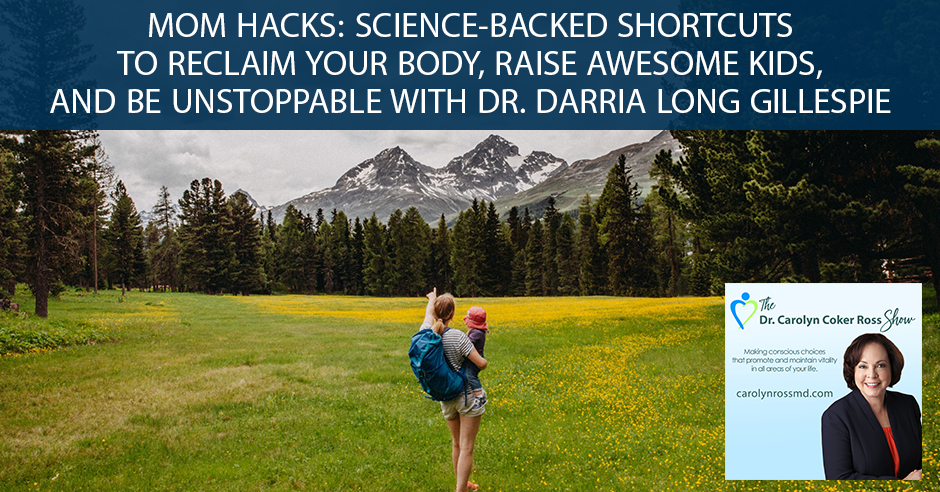
—
Listen to the podcast here:
Mom Hacks: Science-Backed Shortcuts to Reclaim Your Body, Raise Awesome Kids, And Be Unstoppable with Dr. Darria Long Gillespie
My guest is Dr. Darria Long Gillespie. Dr. Gillespie is a Harvard and Yale-trained emergency room doctor on the faculty at the University of Tennessee’s Erlanger Hospital. Her ability to stay calm and take charge during chaos has proved to be a valuable asset in the emergency room. Dr. Long Gillespie’s expertise on topics such as Zika, Ebola, measles, women’s health, parenting and heart health has also led her to appear on CNN, HLN, The Dr. Oz Show, The Doctors and to speak regularly at health conferences across the country. Her first book, Mom Hacks, is due out February 2019. Welcome to the show, Darria.
Thank you so much, Carolyn. It’s a pleasure.
You wrote a book. What prompted you to write Mom Hacks?
It’s coming out in February. It feels like it’s my third child with a due date of February 2019. It does become another child. Writing a book was a life goal for me. What started all of this, if you go back a little bit, I was in residency. I’d always been healthy and never had any medical problems. Suddenly in my intern year, I started waking up with swollen feet, ankles, knees and my hips. My hands when I woke up were swollen. Thick, fat fingers, red, painful, everything hurt. It came out of the blue. I had no idea. You have medical student syndrome, so I quickly diagnosed myself with everything from syphilis to tuberculosis, as everybody does when they’re in this field. I was in a lot of pain and I had seen one doctor and nobody in my family has any issues with arthritis. I had gone to a second opinion in Boston and was in so much pain. I realized I’d left my car unlocked. I was about 50 feet away. Still, to this day, I remember standing in that parking lot and I hurt so badly. I remember thinking about it, “I don’t care. Let them steal my car. I am not walking back. It is enough to get me to the doctor’s office. I can’t walk back.”
What were you eventually diagnosed with then?
[bctt tweet=”We’ve evolved to the point where we have a cave man brain in a modern world.” username=”CarolynCRossMD”]I was eventually diagnosed with psoriatic arthritis. They put me on an injectable medication. I was giving myself injections twice a week. I have patients that give themselves twice a day and more so that in itself has no heroism on my part. You’ve worked in the ER, I was now immunosuppressed. Meaning my immune system was weakened and I was taking care of patients with every single diagnosis or illness and potentially always at risk of getting ill myself. It was great that my systems were at bay, but now I was on this medication for life. I was told, “This is the way it’s going to be and there’s nothing you can do about it.” I started researching and I remember starting to make some changes to my sleep, stress and diet. I remember being told by somebody, “That’ll never work.” It worked. There is Western medicine. Thank goodness for it. This is not to say, “Do this one little lifestyle change to go off all your medications.” That’s not my point. I was able to find things that made a massive difference and able to eventually come off medication. When I was pregnant with my first child, I remember being told by a mom, I was talking about going for a run and she said, “Once you’re a mom, you’re never going to go to the gym again.” It was that exact same voice. It lit up the exact same regions of my brain that said, “What’s going on here?” I looked at the research. For every additional child, a woman has her risk of obesity rise by 7%. Just by being a mom, you’re at higher risk of poor nutrition, less sleep, higher stress and less exercise.
Do you think that’s because, in our culture, we don’t have a lot of family or social support for being a mom?
That is a huge thing. They say it takes a village because it does. It’s hugely stressful. I don’t have a lot of family close nearby and it’s stressful. You don’t have that backup. We as girlfriends, we got to be each other’s backup. The hacks are in Mom Hacks. I used to give them to people, whether they’re moms, grandmothers or have no children at all. It resonates to all of them. Women in general now are under this pressure to do so many different things, to put those things above their own health and that if they do consider their health, you’re just prioritizing yourself first.
I was talking to someone about this and she was working with a client who described taking care of yourself as being selfish. Most women are trained to take care of other people first and then if there’s any time left, they’ll take care of themselves.
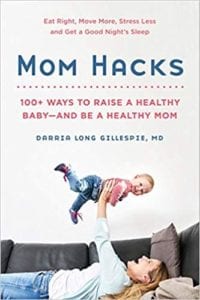
Mom Hacks: 100+ Science-Backed Shortcuts to Reclaim Your Body, Raise Awesome Kids, and Be Unstoppable
There’s something called Caregiver Syndrome, which the person who does that becomes ill because they are taking care of somebody else. There is the expression, “You put your own mask on first.” As a new mom, if you tell me to put my mask on before my child, I’m probably going to say, “Sorry, I’m putting my oxygen mask on my kid first. I don’t care.” I acknowledge that. I wasn’t going to leave my child so I could go do Pilates. I said, “How can I find something where we’re putting on our mask simultaneously? How can I create systems and hacks that help me be healthy at the same time that my child is improving too?”
What kinds of things did you figure out that help you?
The last thing we need is for me to come up and say, “You need to work harder. Maybe you should use more willpower or eat celery instead of chocolate.” If you say those things to a group of women, somebody’s likely to punch you in the face. A lot of the research, I incorporated the best of Western medicine, but a lot of behavioral psychology and behavioral economics. We have a caveman brain in a modern world. Our bodies and our brains have developed over millennia where things like sugar, salt and fat were scarce or we went to sleep with the sun because that was the only source of light we had. Fast forward, in the last 150 years, our environment has drastically changed. Fat, sugar, salt are everywhere. Exercise is hard to get. We have a billion things keeping us up at night and a different way of stress bombarding us. Our bodies are not evolved to handle that. They spent thousands of years evolving to the old method and the environment’s changed quickly. One of the first things was, “Instead of fighting this, instead of fighting the environment and how my body is evolved for 2,000 years, how can I make design changes?” I say DARE. The D is design your environment. How can you make design changes to make your environment easier since you’re less tempted or you’re less kept up by a bright light that throws off your circadian rhythm? You can be less stimulated by that constant little death by a thousand cuts, little tiny stressors we have all day long. Instead of fighting our body, instead of fighting our brain, working with it and changing your environment.
Give me an example of some of the design changes you’ve made.
That’s why I put this first because these are some of the easiest things to do. I don’t believe them and people are like, “Does that work?” Many people have heard, “Put the healthy where you can see it, the less healthy where you can’t see it.” We know that, but what does it do? There was some research in the University of Utrecht. Apparently, behavioral psychologists as a note, their currency are M&M’s and chocolate candies. That’s how they measure everything. They looked at how much chocolate people ate if the chocolate container was right next to them in a chair, three feet away so they had to reach or six feet away meaning you had to get up out of your chair and move to reach to get it. They found that if it was six feet away that you had essentially one single obstacle that you had to get up out of your chair, people ate one-third as much as they would have.
They ate 30% of what they would and they didn’t have any more cravings. That means that we are so lazy that laziness trumps chocolate. Instead of fighting that laziness, use that laziness. Sometimes I tell people, “If it’s tempting, you’re trying to break that habit, get rid of it out of the house.” Sometimes with kids and family, you have to keep it in the house. Put it someplace where there is one obstacle between you and the food. Maybe you have to get the stepstool, pull the step stool over and get it. That alone is going to reduce the amount of time you need it. I was telling this to one mom. After I had been talking to her, she said, “We’d been having this issue. I couldn’t stop eating my Halloween candy and then we followed your advice. We put the stool in between and all of a sudden, I haven’t had any in a month. I haven’t craved it.”
[bctt tweet=”Women in general now are under this pressure to do so many different things. ” username=”CarolynCRossMD”]It’s brilliant to redesign your environment in that way. Even small changes like that can make such a big difference.
It is and that’s what the point of hacks is like, “I don’t have any time.” You’ve worked in the ER. I’m an ER doctor. I have two kids. They’re four-and-a-half and one-and-a-half. I get that and I know what that feeling is so I didn’t need some massive overhaul system. It’s like, “What is the smallest thing I can do that’s going to have the biggest impact?” That was one. Another simple design thing is the light in your home. What many of us don’t realize is how much that bright light affects us and it throws off your circadian rhythm. Your circadian rhythm doesn’t just control how much you sleep. It controls hormones, metabolism and a host of other processes. There was a study out of Harvard where they took students and they totally screwed up their circadian rhythm and totally screwed up their sleep. They were waking them up at midnight and telling them to go to sleep at 3:00 in the morning. In nine days, their cholesterol was higher, their blood pressure was higher and a third of them would have tested positive for prediabetes.
In the old days in the emergency room, we would work 24-hour shifts. We would be awakened at midnight or 2:00 AM. That’s one of the reasons why I left emergency medicine because I was sensitive to those changes in my sleep patterns that it affected me. Did all of this help you with your arthritis?
I had the same problem with overnight shifts, not the day after the overnight shift but the next day. My joints would always be more swollen. I was a little bit delirious. Each time I would pick fights with my husband and never be at my best. Cutting back on those overnight shifts but also then taking some big changes to cut sugar out of my life. Partly with that crazy ER schedule, I used to carry a bag of Skittles in my white coat pocket. In the middle of a shift, I would pop a bag of Skittles right then and there. Cutting that and changing that sugar habit made a massive difference. Sleep, sugar and also getting a handle on my stress, not making it go away because we can’t live in a Pollyanna world, but controlling how it affected me. Those were the three biggest things that made a change for me in my arthritis.
What are some of the other hacks that you talk about in your book?

Mom Hacks: Your brain doesn’t care how long you’re walking. It cares that that pattern is in place.
I said DARE. That D was design. The A is automate. Our brain loves habits. This is another place. It’s like, “How can we use what our brain likes to do?” The design uses laziness. Automate uses habits. How do we create tiny, good habits in our day? We have habits. You get into the car and put on your seatbelt. You get home and take off your shoes. Smokers have habits and it’s about breaking bad habits. When you try to help somebody quit smoking, you find out, “What’s your cue or your trigger to smoke?” and you go there. It’s the same for habits. What is that cue that can get you to do what it is you want to do? BJ Fogg is a behavioral psychologist out of Stanford who talks about tiny habits. If anybody wants to start an exercise habit, I say start small. Figure out your cue and the cue needs to be something that happens every day. Maybe it’s when you wake up, which is what I use or when you drop the kids off to school or when you get home,or after you load the dishwasher after dinner. Choose something that you’re always consistent and then choose the habit you want, but then dial it back.” You want to be someday running three miles. Don’t start there. Start with walking five minutes because all you want to do is build that neural pathway of, “I load the dishwasher, I walk. Load the dishwasher, I walk.” Your brain doesn’t care how long you’re walking. It cares that that pattern is in place.
Usually for most people, once they’re out there doing it, they start to enjoy it. I’m embarrassed to tell you that for many years I struggled with making my bed and I did the same thing. I live alone so nobody sees my bed. You could say, “Why do you need to make your bed?” but it was a personal goal for myself. I live in a house in San Diego where it takes a while for the shower water to get warm. I get up in the morning, I turn on the shower and then I automatically go and make my bed because I have to wait for the shower water to warm up. It’s been working now for a couple years.
Doesn’t it feel good? That’s part of it. You get to then mentally check off, “Bed made.” That’s why I want people to keep it small because I would much rather somebody do something small, make your bed, walk for five minutes, do two pushups and have that mental, “Check. Got it done,” rather than, “I’m a failure. I didn’t run for 30 minutes.” You’re working against your body so don’t do that. Another habit that I love is called temptation bundling, which sounds so much less than it probably is. Tell me, Carolyn, do you have an indulgence that you love that you feel guilty about? Maybe you watch Game of Thrones or a junk magazine. Do you have something like that?
People Magazine.
Find that thing that you always feel a little guilty about and then find the exercise that you want to do. Maybe it’s walking on the treadmill or climbing on the stair climber. Now you have your temptation, your activity. I say, “Take that People Magazine and the only time you can read it is when you’re walking on the treadmill or when you’re on that stair climber, that’s the only time.” You have to do that. You have to stick to it. You have to be a little bit police-y about that. When the magazine arrives in the mail, this sounds crazy but you get this little hit of like, “I’m looking forward to the next time I get to work out because I got to find out what’s going on with Harry and Meghan.”
[bctt tweet=”Our brains are wired to look for the negative.” username=”CarolynCRossMD”]That makes sense because it does spike the dopamine. Once you experience pleasure doing something, just anticipating doing something will make your brain produce a little dopamine spike. When you bundle those, it makes sense physiologically because you’re going to get that feel good feeling even before you do the activity.
When they did this at Wharton, they found that those students, who only were allowed to look at that temptation while they were exercising, exercised 50% more.
I have a background in Integrative Medicine. I trained with Andrew Weil in Tucson about this. I’m wondering if you were able to employ any integrated therapies, whether it is mindfulness, acupuncture or anything like that.
Andrew Weil’s such an amazing person. I’ve never met him, but that’s amazing that you trained with him. I said DARE, dare to change. Design, automate. R is reframe and that’s where I get to a lot of the mindfulness stuff. I feel that in this world, we end up using a lot of our brain power on those things in the D and the A, design and automate. Those exhaust us. “Should I eat? When am I going to work out? I’m hungry. What’s for dinner?” If you can design and you can automate, now you’re freeing up your brain power and now you can put it in the R, reframe the things that need it. This is where there’s mindfulness and how it stops automatic negative thoughts and that automatic negative loop that we all have in our monologue. Acupuncture is not in the book. I personally used acupuncture when I was trying to get pregnant with my second child. There’s a lot of research with acupuncture in a variety of conditions. It’s not the book, but I’m an enormous advocate of acupuncture. I’ve seen significant changes for people. Getting back to the other part of that was the mindfulness.
Do you meditate?

Mom Hacks: Reach out so you’re connecting because technology isn’t all bad. It can connect us.
You’ve worked in the ER. I’m an ER doctor, so we talk about meditation the first time. If I laughed, I was like, “I don’t meditate. That’s not what ER doctors do.” I realized like, “That means I need it more than pretty much anybody.” I do pretty regular TV and for some reason, one after the next, eight in a row, had people talking about how they meditate. I was like, “I get the message. I’ll start,” so I do. My little morning routine is I wake up. I do a little five to fifteen-minute meditation. Depending on the day, I either run for a mile or I run for three miles. That’s tiny. Some days I can’t get three miles in, so I do my one mile. Especially with the two munchkins, it depends on what time my eighteen-month-old wakes up. I do a little meditation, either a Deepak Chopra meditation that I like. I’m doing Gabrielle Bernstein meditations.
When I was in medical school, someone turned me onto transcendental meditation. I have to say I credit TM with getting me through medical school in my internship because I was so stressed. I had children in med school. I had an eight-year-old. I was stupid because I didn’t realize how hard it was going to be with kids. Doing TM helped me to get through that process.
It’s not stupid. Nobody has any idea what either residency is like or what having children is like. There was no way you would have known.
Maybe I could have gathered more information though before.
There’s never a perfect time, but yes. I have not done TM. I’ve been curious about it. There’s a TM center here in Atlanta and I’ve reached out to them. Nowadays, not having time to go someplace and I’ve been doing it at home. If you have any favorite TMs I can do online, I will add them to my morning routine and swap them in.
[bctt tweet=”Whether you’re a mom or not, see the beauty of the forest around you for a minute or two every day. That of itself keeps us moving forward. ” username=”CarolynCRossMD”]I don’t think it matters what you do. It’s just doing it that matters. The easier I did, the better. I work with a lot of people with behavioral related issues, addictions, eating disorders, that’s what I do nowadays. It’s the hardest thing in the world is to change your behavior. Either to start a new behavior that you want to do or to end something that you don’t want to do. These hacks that you’re talking about are useful because it gives people a capsulization of what the research shows about what makes things work and not work.
I’m obsessed with the research. Every one of these hacks was a little mini-research paper, which about near killed me at times. I wasn’t going to share anything unless I knew it was truly research-backed. It would truly help people because what I most want to give people is hope. Their best is ahead of them and it doesn’t take an enormous lift. It takes small changes putting one foot in front of the other.
What are the ways that you find time to be present with your children? I see so many moms nowadays who are busy and rushing and use their phones as a way to deal with their own stress or stay connected at work, etc. I often am in Starbucks or someplace and a mom is on the phone and her child is just sitting across from her.
You read my mind because as you were asking, I wrote down two things to end. One of them was no devices. Yes, I’m in the media world. I do with TV and social media, so I have to be connected to my phone but I do that sparingly. One of the things is when I’m with my kids, I put down the phone. If I have to pick it up, say I have to return a text or there is something in the rare instance, I’m never with them looking for things. I only respond if something gets pushed in. If that happens, I’ll tell my child, “I need to send this. I want to keep doing what we’re doing right now. Let me just send it.” There’s some connection. I know that’s not the same, but that’s number one is putting the device down. That saves up time. People on average are spending a half hour or more scrolling through social media. That’s a half hour to read to your child, play or go run on the treadmill. Those social media don’t make us feel good. They tend to make us feel worse feelings about ourselves.
Not only does it take up time, but it also makes you feel like crap half the time. Number one is I put down the devices when we’re having a meal there is no device at the table. Studies have shown that having the device at the table, even if it’s face down, will decrease engagement and decrease conversation so I put it away. Number two, having that device means you’re multitasking. Anybody out there who does that knows. You try to buy your shampoo on Amazon, talk to your child and fix dinner. You’re going to buy fifteen shampoos on Amazon and you’re probably going to totally screw up dinner and nobody’s happy. A single task, do the one thing that you need to do at that moment and block out. When I’m writing, I turn off my phone. The only person who can get through is my husband and the babysitter. Everything else is turned off.
The other thing I hear about from a lot of clients and friends of clients who say that so many moms of young children are bored with spending time with their kids and that I don’t understand.
I see what they mean. It’s a different part of my brain because suddenly it’s like, “Let’s play Calico Critters again, mom.”
For me, it was, “Let’s watch Lion King for the fifteenth time.”
Part of it is engaging with your kids at the time. You crave that adult connection. That’s probably why they’re doing social media is they’re craving some of that adult connection. I also think it’s us dulling the feeling. We’re a little bit anxious. This was much to do. Now we’re playing with the kids and they’re may be arguing. Play with your kids and then maybe take five minutes and go do social media. Knock yourself out or text your girlfriends. Don’t do social media. Text the same people you’d be social stalking instead. Tell them they’re fantastic about your day or ask them a question. Reach out so you’re connecting because technology isn’t all bad. It can connect us. Take your time to do that, but not while you’re doing with your kids.
The same thing that also goes for everybody is seeing the beauty of the forest or the trees. Our brains are wired to look for the negative. I had taken my kids on a walk and it’s fall here. Here that means that we have spiders and those big brown spiders that tend to come out. I was walking with the kiddos. I was looking down on the ground for poison ivy or thorns. I was carrying a stick to wack through the trail to make sure I didn’t walk face first into a spider web. Three-quarters of the way through I realized, “I didn’t look up at all.” I didn’t see the forest or trees. Sometimes you hear people say, “Enjoy this time,” and you want to be like, “Do you want to come to my house at 2:00 in the morning?” What they mean to say and they don’t realize it, is just be present. Lift your eyes from the poison ivy, spider webs, dirty diapers and temper tantrums. Lift your eyes for a second to see the beauty of the trees and the beauty of that moment. Smell your baby child and take a moment, even if it’s for two minutes. That’s what we all need to do, whether it’s your children, your work or whatever you’re doing. Whether you’re a mom or not, see the beauty of the forest around you for a minute or two every day. That of itself keeps us moving forward.
Dr. Darria, it’s been a pleasure having you on the show. Do you want to let people how they can get your book in February? What’s your website address as well?
Mostly it’s how we can engage together. My website is DrDarria.com. I’m on Instagram, Twitter and Facebook, all of them as Dr. Darria. Sign up for the newsletter. We’re going to be starting to do some hacks, groups and playing with some different things on social media. I’d love to hear from people and engage with them there too. When they go on my website, they can find out DrDarria.com/MomHacks. It’s how they can find the book. It’s also on Amazon if you search for my name there.
It’s been a pleasure talking to you.
Thank you so much, Carolyn.
Important Links:
- DrDarria.com
- Instagram – Dr. Darria Long Gillespie
- Twitter – Dr. Darria Long Gillespie
- Facebook – Dr. Darria Long Gillespie
- DrDarria.com/MomHacks
About Dr. Darria Long Gillespie
 Dr. Darria Long Gillespie is a Harvard & Yale-trained ER doctor on faculty at Erlanger Hospital Emergency Medicine, SVP Clinical Strategy at Sharecare, and a Clinical Assistant Professor of Emergency Medicine at The University of Tennessee. Her ability to stay calm and take charge during chaos proved her to be a valuable addition in the ER. Dr. Long Gillespie’s expertise on topics such as Zika, Ebola, measles, women’s health, parenting, and heart health has led her to appear on CNN, HLN, The Dr. Oz Show, The Doctors and to speak regularly at health conferences across the country. Her first book, Mom Hacks, is due out February 2019.
Dr. Darria Long Gillespie is a Harvard & Yale-trained ER doctor on faculty at Erlanger Hospital Emergency Medicine, SVP Clinical Strategy at Sharecare, and a Clinical Assistant Professor of Emergency Medicine at The University of Tennessee. Her ability to stay calm and take charge during chaos proved her to be a valuable addition in the ER. Dr. Long Gillespie’s expertise on topics such as Zika, Ebola, measles, women’s health, parenting, and heart health has led her to appear on CNN, HLN, The Dr. Oz Show, The Doctors and to speak regularly at health conferences across the country. Her first book, Mom Hacks, is due out February 2019.




